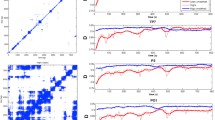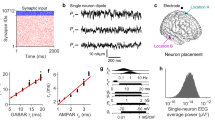Spectral EEG analysis studies showed that in the state of “animal hypnosis,” the known increase in the power of biopotentials in the delta frequency range (0.3–3 Hz) and decrease in the theta range (4–8 Hz) were accompanied by an increase in the sigma range (12–17 Hz) by a factor of 2–4 and a decrease in the gamma range by a factor of 1.5–2, particularly in the band 40–70 Hz. These changes were more marked in the anterior areas of the cerebral cortex. The effects of the hypnotic state on pharmacologically (ketamine) induced increases in gamma activity of cortical origin were studied. Administration of subanesthetic doses of ketamine to rabbits induced motor arousal, while brain electrical activity showed longlasting (up to 2 h) increases in gamma activity. Creation of the hypnotic state on the background of ketamine produced a virtually instantaneous rearrangement of the power spectrum, which sharp increases in values in the slow-wave frequency range and a decrease in gamma activity, which returned to the baseline level. Thus, creation of the hypnotic state eliminated the specific ketamine-induced rearrangements of biopotentials, suggesting that animal hypnosis has stabilizing and to some extent protective effects in behavioral states accompanied by hyperlocomotion and stress.
Similar content being viewed by others
References
V. N. Dumenko, High-Frequency EEG Components and Operant Learning [in Russian], Nauka, Moscow (2006).
R. A. Pavlygina, E. V. Rusinova, G. Ya. Roshchina, V. I. Korolev, V. I. Davydov, A. V. Bogdanov, and A. G. Galashina, “The nature of animal hypnosis,” Prob. Neirokibernitiki, Rostov-na-Donu, No. 1, 69–72 (2005).
E. V. Rusinovo and G. Ya. Roshchina, “Interactions of the electrical activity of the sensorimotor cortex and hippocampus in ‘animal hypnosis’ in rabbits,” Zh. Vyssh. Nerv. Deyat., 50, No. 4, 600–607 (2000).
E. V. Rusinovo and G. Ya. Roshchina, “Intercentral reticulo-cortical relationships in electrical activity during the state of animal hypnosis in rabbits,” Zh. Vyssh. Nerv. Deyat., 52, No. 3, 341–346 (2002).
P. V. Simonov, “The nature and physiological mechanisms of animal hypnosis,” in: The Brain and Behavior [in Russian], Nauka, Moscow (1990), pp. 16–22.
N. D. Sorokina, G. V. Selitskii, and N. S. Kositsyn, “Neurobiological studies of brain bioelectrical activity in the gamma rhythm range in humans,” Usp. Fiziol. Nauk., 37, No. 3, 3–10 (2006).
E. Basar, C. Basar-Eroglu, S. Karakas, and M. Schurmann, “Brain oscillators in perception and memory,” Int. J. Psychophysiol., 35, No. 2–3, 95–124 (2000).
G. Carli, F. Farabollini, and G. Fontani, “Effects of pain, morphine and naloxone on the duration of animal hypnosis,” Behav. Brain Res., 2, No. 3, 373–385 (1981).
J. A. Castiglioni, M. I. Russell, B. Setlow, K. A. Young, J. C. Welsh, and I. Steele-Russell, “An animal model of hypnotic pain attenuation,” Behav. Brain Res., 197, No. 1, 198–204 (2009).
M. Cavazzuti, C. A. Porro, G. P. Biral, C. Benassi, and G. C. Barbieri, “Ketamine effects on local cerebral blood flow and metabolism in the rat,” J. Cereb. Blood Flow Metab., 7, No. 6, 806–811 (1987).
L. F. Da Silva and L. Menescal-de-Oliveira, “Role of opioidergic and GABAergic neurotransmission of the nucleus raphe in guinea pigs,” Brain Res. Bull., 72, No. 1, 25–31 (2007).
G. E. Duncan, J. N. Leipzig, R. B. Mailman, and J. A. Lieberman, “Differential effects of clozapine and haloperidol on ketamineinduced brain metabolic activation,” Brain Res., 812, 65–75 (1998).
Swiss Academy of Medical Sciences, “Ethical principles and guidelines for experiments on animals,” Experientia, 51, 1–3 (1995).
G. Fontani, F. Grazzi, G. Lombardi, and G. Carli, “Hippocampal rhythmic slow activity (RSA) during animal hypnosis in the rabbit,” Behav. Brain Res., 6, No. 1, 15–24 (1982).
C. J. Green, J. Knight, S. Precious, and S. Simpkin, “Ketamine alone and combined with diazepam or xylazine in laboratory animals: a 10-year experience,” Lab. Anim., 15, 163–170 (1981).
D. W. Gross and J. Gotman, “Correlation of high-frequency oscilla-tions with the sleep-wake cycle and cognitive activity in humans,” Neurosci., 4, 1005–1018 (1999).
A. R. Haig, E. Gordon,V. De Pascalis, R. A. Meares, H. Bahramali, and A. Harris, “Gamma activity in schizophrenia: evidence of impaired network binding,” Clin. Neurophysiol., 111, No. 8, 1461–1468 (2000).
Hao Lei, O. Grinberg, C. I. Nwaigwe, H. G. Hou, H. Williams, H. M. Swartz, and J. F. Dunn, “The effects of ketamine-xylazine anesthesia on cerebral blood flow and oxygenation observed using nuclear magnetic resonance perfusion imaging and electron paramagnetic resonance oximetry,” Brain Res., 913, 174–179 (2001).
C. S. Hermann and T. Demiralp, “Human EEG gamma oscillations in neuropsychiatric disorders,” Clin. Neurophysiol., 116, 2719–2733 (2005).
W. R. Klemm, “Drug effects on active immobility responses: what they tell us about neurotransmitter systems and motor functions,” Progr. Neurobiol., 32, 403–422 (1989).
W. R. Klemm, “Behavioral arrest: in search of the neural control system,” Progr. Neurobiol., 65, 453–471 (2001).
T. Kubota, N. Anzawa, K. Hirota, H. Yoshida, T. Kushikata, and A. Matsuki, “Effects of ketamine and pentobarbital on noradrenaline release from the medial prefrontal cortex in rats,” Can. J. Anaesth., 46, No. 4, 388–392 (1999).
L. Mackenzie, K. J. Pope, and J. O. Willoughby, “Gamma rhythms are not integral to EEG spindle phenomena,” Clin. Neurophysiol., 116, 861–870 (2005).
A. Maksimow, M. Sarkela, J. W. Langsjo, E. Salmi, K. K. Kaisti, A. Yli-Hankala, S. Hinkka-Yli-Salomaki, H. Scheinin, and S. K. Jaaskelainen, “Increase in high frequency EEG spectral entropy monitor during S-ketamine anesthesia,” Clin. Neurophysiol., 117, No. 8, 1660–1668 (2006).
K. J. Maloney, E. G. Cape, J. Gotman, and B. E. Jones, “High-frequency electroencephalogram activity in association with sleep-wake states and spontaneous behaviors in the rat,” Neurosci., 76, No. 2, 541–555 (1997).
M. Ramos Coutinho, L. F. da Silva, and L. Menescal-de-Oliveira, “Modulation of tonic immobility in guinea pig PAG by homocysteic acid, a glutamate agonist,” Physiol. Behav., 94, No. 3, 468–473 (2008).
R. D. Traub, M. A. Whittington, I. M. Stanford, and J. G. Jeffreys, “A mechanism for generation of long-range synchronous fast oscillations in the cortex,” Nature, 383, No. 6601, 621–624 (1996).
S. Uchida, T. Maehara, N. Hirai, Y. Okubo, and H. Shimizu, “Cortical oscillations in human medial temporal lobe during wakefulness and all-night sleep,” Brain Res., 891, No. 1–2, 7–19 (2001).
Author information
Authors and Affiliations
Corresponding author
Additional information
Translated from Zhurnal Vysshei Nervnoi Deyatel’nosti imeni I. P. Pavlova, Vol. 60, No. 3, pp. 352–363, May–June, 2010.
Rights and permissions
About this article
Cite this article
Roshchina, G.Y., Koroleva, V.I. & Davydov, V.I. Changes in the High-Frequency Activity of Rabbit Brain Biopotentials in the State of “Animal Hypnosis”. Neurosci Behav Physi 41, 772–780 (2011). https://doi.org/10.1007/s11055-011-9486-6
Received:
Accepted:
Published:
Issue Date:
DOI: https://doi.org/10.1007/s11055-011-9486-6




